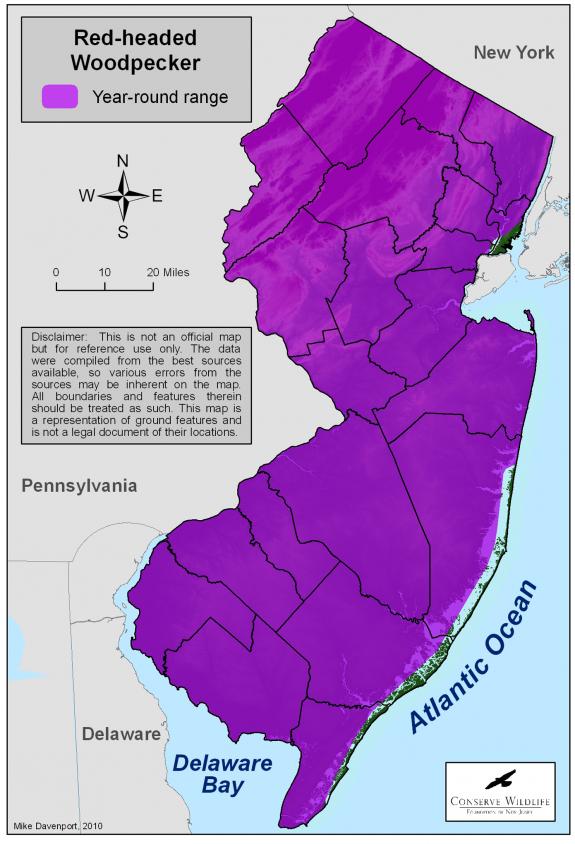Melanerpes erythrocephalus
Type: bird
Status: threatened
Species Guide
Red-headed woodpecker
Melanerpes erythrocephalus
Species Type: bird
Conservation Status: threatened
Identification
The red-headed woodpecker is a robin-sized bird. It can be easily identified by its vibrant black, white, and red plumage. It has brilliant red feathers on its head, neck, and throat. Its breast feathers are white are separated from the red feathers by a thin black border. The belly, undertail feathers (coverts), and rump are white. The tail, back, and upperwing feathers (coverts) are black. Its inner flight feathers (secondaries) are white. They contrast with the outer flight feathers (primaries) which are black. This coloration forms a white patch on the inner wing that is striking in flight.
Though they lack the striking plumage of adults, juvenile red-headed woodpeckers are similarly patterned. The head and wings of juveniles are brown. The belly is white and has a variable amount of brown streaking. The back is brown with dark brown barring. The white wing patch is also marked with dark barring. Juveniles molt into adult plumage during their first fall and winter.
The male is slightly larger than the female. The sexes are indistinguishable by plumage. The iris is brown and the legs are gray. The chisel-shaped bill is heavy and colored blue-gray. Like other woodpeckers, the red-headed has zygodactyl feet. Two toes point forward and two point backward. This enables them to cling vertically to trees. The tail feathers are specially adapted by being very stiff and pointed. This supports the woodpecker when they cling to the bark of trees. Red-headed woodpeckers fly low over the ground in an up and down (undulating) flight. The call of the red-headed woodpecker is a repeated “qweer”.

Distribution & Habitat
The red-headed woodpecker breeds in eastern North America from southern Canada west to central Texas and the eastern Rocky Mountains, east to the Atlantic Coast, and south to the Gulf Coast and Florida. They winter in the eastern U.S., south of Iowa and in New Jersey.
Red-headed woodpeckers inhabit open upland and wetland forested areas. Forested areas that contain dead or dying trees and sparse undergrowth are preferred. This type of habitat is often created by disturbances such as fire, flooding, or insect outbreaks. A sparse understory is favored for foraging. Dead or dying trees are required for nesting. Red-headed woodpeckers occupy similar habitats throughout the year. They seek wintering sites such as open riparian or pine forests and orchards that contain nut and mast producing trees.
Diet
The red-headed woodpecker is considered to be an omnivore. They eat both plant and animal matter. They are known to consume invertebrates, acorns, beechnuts, chestnuts, fruit, seeds, berries, corn, lizards, mice, eggs, and even the young of other birds. Their diet is varied by the seasons. They primarily eat animal matter in the spring and summer and plant matter in the fall and winter.
They catch many insects while in flight. They store food that is sometimes covered up for later consumption. They are known to pin live insects, like grasshoppers, into tree crevices. In winter, acorns are collected and stored within tree crevices as well. These woodpeckers vigilantly defend their food caches from potential thieves, which include crows, blue jays, and other woodpeckers.
Life Cycle
Courtship begins in May when the male calls and taps within a potential nest cavity. He presents several new or previously occupied nest cavities to the female. She selects which nest cavity they will use to raise their young. Nest cavities are located at varying heights in dead trees or tree limbs of live trees. Entrance holes are around 4.5 in. in diameter. Cavities range from 8 to 14 in. deep to 3 to 4.5 inches wide. Adults actively defend their cavities from other cavity nesting birds like chickadees, tufted titmice, and European starlings.
Females lay 4 to 5 white eggs from early May to late June in New Jersey. Both the female and male incubate the eggs for approximately 14 days. Both adults care for the young until they fledge in about 30 days. Some pairs may produce a second brood in the nesting season.
Current Threats, Status, and Conservation
During the late 1700’s and 1800’s, the red-headed woodpecker was a common and widespread species in the Northeast. In the late 1800’s, large concentrations of these birds were observed during fall migration in New York and Long Island. Now they are considered to be an uncommon migrant there. Today, only a handful of migrants are observed during migration in Cape May.
By the turn of the 20th century, red-headed woodpeckers had suffered population declines due to several different factors. Road mortality, competition with European starlings for nesting cavities, and harvesting for their feathers all contributed to their decline. Many populations of avian species were greatly reduced to provide feathers for women’s hats. Farmers also killed red-headed woodpeckers because they damaged fruit and berry crops. Further population declines were observed from the 1930’s to the 1970’s. Habitat loss, the limited availability of nesting sites, and road mortality exacerbated their decline.
Currently, the species is considered to be rare in the Northeast. The red-headed woodpecker was listed as a threatened species in New Jersey in 1979.
Habitat loss continues to threaten and limit this species’ range in New Jersey.
References
Beans, B. E. and Niles, L. 2003. Endangered and Threatened Wildlife of New Jersey.
Edited and updated in 2010 by Ben Wurst.
Scientific Classification
- Kingdom: Animalia
- Phylum: Chordata
- Class: Aves
- Order: Piciformes
- Family: Picidae
- Genus: Melenerpes
- Species: M. erythrocephalus